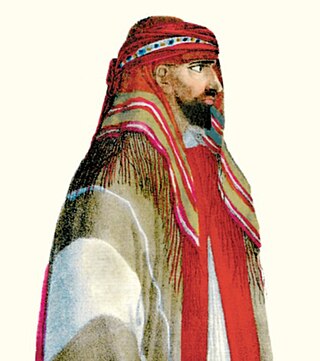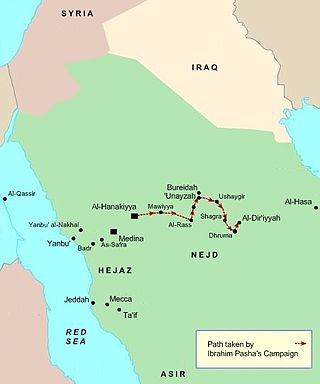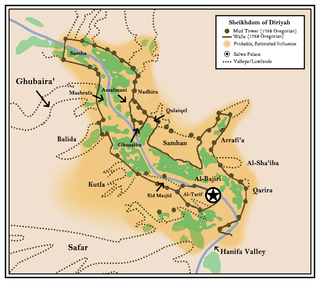
Abdullah bin Saud Al Saud was the ruler of the First Saudi State from 1814 to 1818. He was the last ruler of the First Saudi State and was executed in Constantinople under the Ottoman Empire. Although the Ottomans maintained several garrisons in the Nejd thereafter, they were unable to prevent the rise of the Emirate of Nejd, also known as the Second Saudi State, led by Turki bin Abdullah.
The Ottoman/Egyptian-Wahhabi War also known as the Ottoman/Egyptian-Saudi War (1811–1818) was fought from early 1811 to 1818, between the Ottoman Empire and the Emirate of Diriyah, the First Saudi State, resulting in the destruction of the latter.

The Emirate of Diriyah, also known as the First Saudi State, was established in February 1727. In 1744, the emir of a Najdi town called Diriyah, Muhammad bin Saud, and the religious leader Muhammad ibn Abd al-Wahhab formed an alliance to found a socio-religious reform movement to unify the many states of the Arabian Peninsula.
Faisal bin Turki Al Saud was the second ruler of the Second Saudi State and seventh head of the House of Saud.
Turki bin Abdullah Al Saud was the founder of the Second Saudi State and ruled Najd from 1823–1834 following administration by the Ottoman Empire.
Saud bin Faisal Al Saud, also known as Imam Saud, (1833—1875) was the ruler of the Second Saudi State in 1871 and 1873–75. He joined alliances with foreign tribes and revolted against his half-brother Abdullah. His rule was short-lived and Abdullah overthrew him. Saud gained power again in 1873 but died two years later. His reign was notable for the infighting in the House of Saud which he initiated.
The capture of Yanbu, or Yanbu Landing, was a bloodless confrontation between the Saudis and Ottomans in 1811.

The Battle of Medina took place in 1812, Following the Battle of Al-Safra, Tusun's forces began to deal with Saudi forces stationed in Medina.

The Najd Expedition was a series of military conflicts waged by Egypt on behalf of the Ottoman Empire from 1817 to 1818. It was part of the Ottoman–Saudi War that lasted from 1811 to 1818. The campaign of 1817/8 was led by Ibrahim Pasha, with the goal of capturing Diriyah and ending the First Saudi State by the order of the Ottoman sultan Mahmud II.

The siege of Diriyah took place in late 1818 at the end of the Wahhabi War of 1811–1818 during the Nejd Expedition.
Abdullah bin Faisal Al Saud was one of the rulers of the Emirate of Najd, also known as Second Saudi State. His reign witnessed extensive struggle among the members of the Al Saud family which led to turmoil in the region.
The Battle of Khakeekera was a naval battle that took place in March 1811 between the forces of Bahrain and of Kuwait on one side, and those of the Emirate of Diriyah led by Rahmah ibn Jabir al-Jalhami, the pirate ruler of Dammam and some villages in Qatar, on the other. The battle took place northwest of Qatar and ended with a Bahraini-Kuwaiti victory.

The Sheikhdom of Dir'iyah, was a polity in central Arabia from 1446 to 1744 and the predecessor to the First Saudi State. Its capital was Al-Turaif District, and it was based around the banks of Wadi Hanifa. It was ruled by the Muani'a dynasty from the Durou' clan, and later under its two branches, Muqrin and Watban, with the former becoming the sole house and the house from which the House of Saud descends.

Muhammad bin Abdullah Al Rashid was one of the Emirs of Jabal Shammar and is known for his defeat of the Saudi State in the battle of Mulayda which ceased to exist for a second time in 1891. His reign lasted from 1869 to 1897, and he was the most influential ruler of the Emirate of Jabal Shammar for which he is called Muhammad the Great.
The Capture of Al Hinakiyah was a military engagement between the Saudi army led by Saud bin Abdulaziz and the Ottoman garrison, who were stationed at Al Hinakiyah, they successfully expelled the Ottoman garrison
The Battle of Turuba took place in 1813 when Ottoman forces besieged Turubah. The garrison was led by Ghaliyya Al Bogammiah who successfully routed the Ottoman army.
In 1814, the Saudis laid siege to the Ottoman-held city of Taif, but the Ottoman governor of Egypt, Muhammad Ali Pasha, successfully forced them to raise the siege.
The Battle of Byssel was a military engagement between the Ottoman forces and the Saudi forces in Byssel. The Ottomans won a decisive battle, which broke Saudi power.
The Dhurma Massacre is a massacre perpetrated by the Ottomans in the Siege of Dhurma, during the Expedition to Najd (1817-1818)
The battle of Mawiyya was fought in 1817 between the Emirate of Diriyah led by Abdullah Ibn Saud and the Ottoman Empire led by Ibrahim Pasha





